Excerpts from Jim Conrad's
Naturalist Newsletter
from the May 3, 2018 Newsletter issued from Rancho Regenesis in the woods ±4kms west of Ek Balam Ruins; elevation ~40m (~130 ft), N~20.876°, W~88.170°; central Yucatán, MÉXICO
STIGMAPHYLLON VINE FLOWERING
Dangling from a Habim tree near the garden, a woody vine with broad, rounded leaves opposite one another on the stems was producing pretty clusters of yellow blossoms, like those shown below:
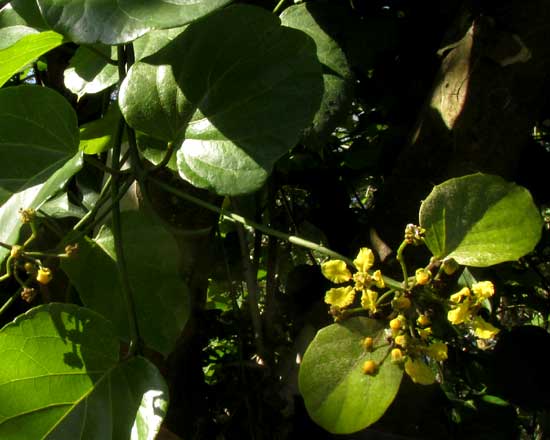
Up close, the flowers displayed very distinctive features, shown below:
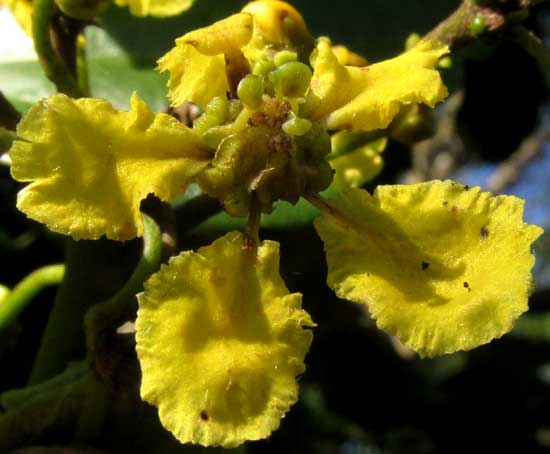
Note that the petals' broad, yellow blades are on slender stalks, or "claws." The style produces three broad, "hooded" stigmas that bend away from one another, and the ovary, instead of being neatly egglike surrounded by stamens, appears to produce thin wings or flaps that hug the petals' claws. A glimpse of the above flower's underside tells us immediately what plant family this vine belongs to, as seen below:
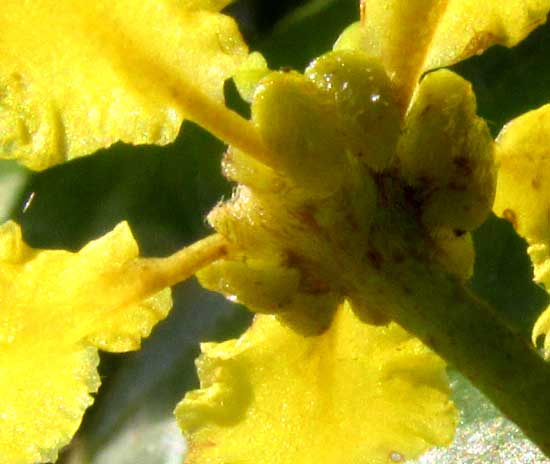
With such greenish pairs of egglike glands situated between the petals' claws, we just have to have a member of the tropical Malpighia Family, the Malpighiaceae. Moreover, we've already seen a vine very similar to this, as you can confirm on our Stigmaphyllon ellipticum page at www.backyardnature.net/yucatan/stigmaph.htm
However, if you closely compare the pictures on that page with the above, you'll see that the flower petals of Stigmaphyllon ellipticum are finely toothed, while petals of this week's vine are irregularly toothed, but not finely. Also, leaves of Stigmaphyllon ellipticum are smaller and more elongated than our current vine's. Is this week's vine just showing a variation of Stigmaphyllon ellipticum, or is it a closely related species? At the CICY Flora de Yucatán website I found listed a second Stigmaphyllon species, STIGMAPHYLLON LINDENIANUM, looking just like our current one. So, here's a second Stigmaphyllon species, and I do enjoy seeing another "variation on the Stigmaphyllon theme."
At the bottom of our Stigmaphyllon ellipticum page you can see that each flower on the vine produces three winged, samara-type fruits. Seeing those, the wings hugging the claws of our Stigmaphyllon lindenianum petals start making sense. It'll be interesting to see what kinds of wings Stigmaphyllon lindenianum fruits produce. Our flower pictures suggest there might be six of them, while the Stigmaphyllon ellipticum fruits show only three.
Stigmaphyllon lindenianum is native from Mexico all through Central America to Venezuela. CICY reports it as both flowering and fruiting every month of the year. Probably I've seen it before, just didn't notice its differences from the other species.
from the June 7, 2018 Newsletter issued from Rancho Regenesis in the woods ±4kms west of Ek Balam Ruins; elevation ~40m (~130 ft), N~20.876°, W~88.170°; central Yucatán, MÉXICO
STIGMAPHYLLON VINE FRUITING
Nowadays Stigmaphyllon lindenianum is fruiting, and below you can see now that also with this species, each flower produces only three or fewer winged fruits:
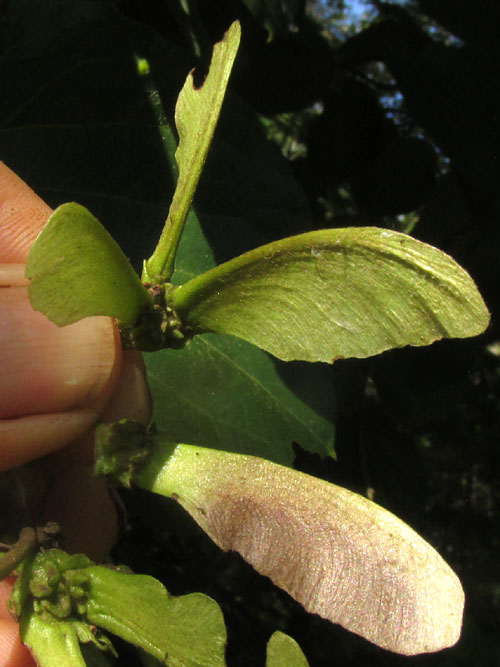
Right below the 3-winged assemblage is a one-winged one. If you enjoy "variations on a theme," you might like to compare the winged fruits of our present Stigmaphyllon lindenianum with those of Stigmaphyllon ellipticum, which we saw at Chichén Itzá appearing at the page's bottom at www.backyardnature.net/yucatan/stigmaph.htm
from the February 1, 2019 Newsletter issued from Rancho Regenesis in the woods ±4kms west of Ek Balam Ruins; elevation ~40m (~130 ft), N20.876°, W88.170°; north-central Yucatán, MÉXICO
FIGURING OUT AN IMMATURE VINE
Amid weedy brush next to the corral several hand-size leaves caught my attention because I'd not seen leaves exactly like these. They're shown below:
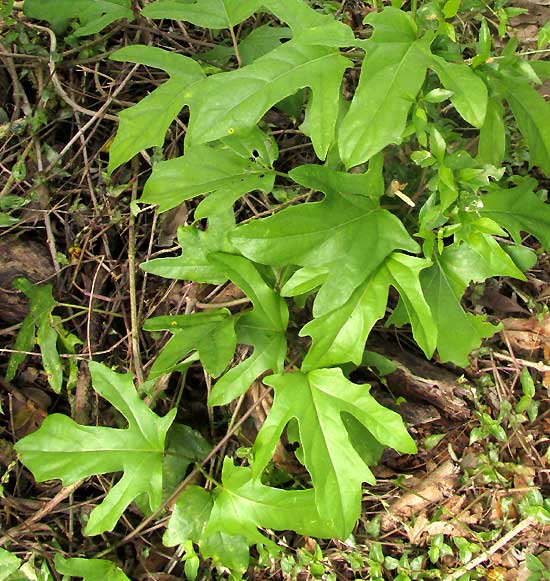
Near that picture's bottom-left corner you can see that the leaves arise opposite one another on a slender, pliable-looking stem. Most plant families produce leaves alternating with one another on the stem, so that simple field mark helps eliminate possible species in many plant families. Also, the stem is so slender that the plant must be a vine. The stem climbed onto a strand of barbed wire, then at a tree trunk the wire was nailed to began wrapping itself around the trunk and growing upward, as shown below:

Most plant families don't produce vines, so this also drastically limited the number of plant families we could be dealing with. Following the vine upward brought me to where the vine's leaves were just beginning to unfold, and those leaves showed some peculiarities, as seen below:
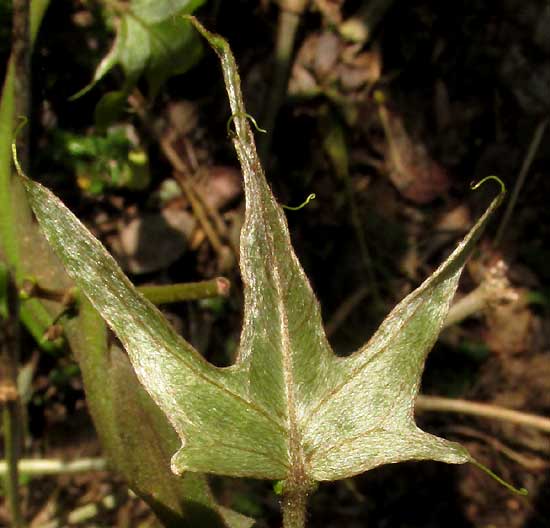
Note how leaf lobe tips narrow to form curling, hairlike appendages, which I'm guessing might hold immature leaves in place when the vine climbs inside dense brush. The leaf blade is white with very slender, silky, close-lying hairs, a condition known as being "sericeous." Also, at the blade's bottom, where it connects to its petiole, notice the two green glands.
At the elongating vine's tip, where tiny leaf blades were just forming and hardly recognizable, the curly hairs that eventually would arise from the lobes' tips already were well developed, and so were the green glands at the future petioles' bases. And ants gathered there, maybe to drink secretions produced by the glands. All this can be seen below:
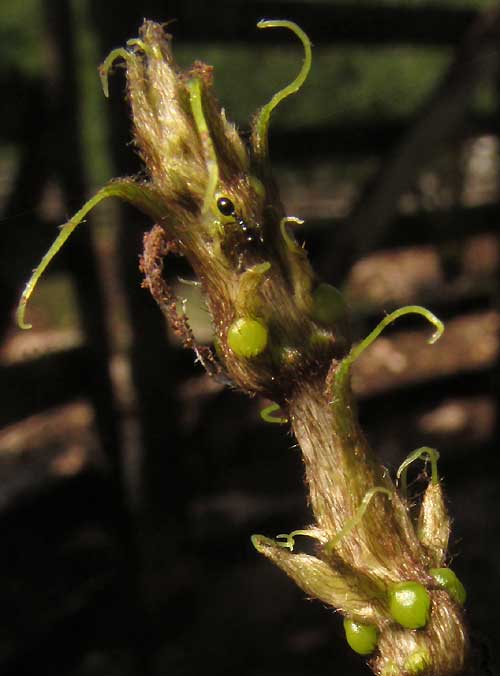
A close-up of a liquid-issuing gland on a fully developed leaf is shown below:
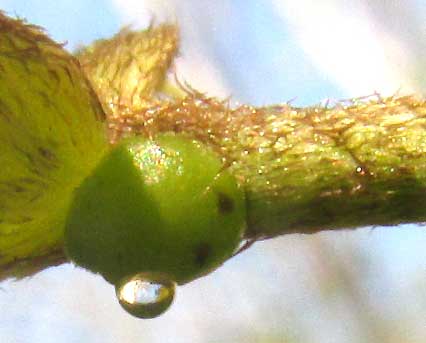
In that picture brown, close-lying hairs cover both the leaf blade and the petiole. The oldest stems where the vine was rooted were mostly hairless, but mature stems a few feet from that point also were densely mantled with similar close-fitting, brown hairs. A picture of a hairy stem node with hairy leaf petioles jutting toward the image's top and bottom is shown below:
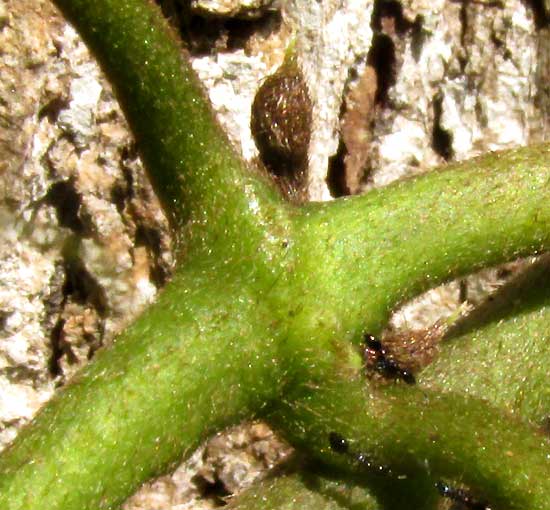
By now I'd decided which family this vine must belong to, mostly because such glands conspicuously occur on flowers in the family, and the family produces many woody vines with opposite leaves. Also, often species in the family are covered with a unique kind of hair. The hair is T-shaped, the T's vertical column being so short that the horizontal bar lies very close to the plant's surface. I looked for such hairs, suspecting that most or all the brown hairs were such T-shaped ones, just that they lay so close to the surface that they looked like they must be rooted at one end. Finally I found a single hair that was unmistakably T-shaped. Pushing my little camera to its limits, I got the picture of that hair shown at the right. Such T-shaped hairs in technical literature sometimes are referred to as "malpighious," because they are typical of the tropical Malpighia Family, the Malpighiaceae, which our vine belongs to.
Such T-shaped hairs in technical literature sometimes are referred to as "malpighious," because they are typical of the tropical Malpighia Family, the Malpighiaceae, which our vine belongs to.
With that, it was a matter of checking which species in the Malpighia Family found in this area produce young leaves of the kind shown here. I was led to a woody vine, or liana, often noticed here when it's fruiting and flowering, Stigmaphyllon lindenianum, on which we've seen green glands similar to those seen here, but on the calyxes of flowers and fruits. {above entry}
Earlier we've seen that leaves produced on older stems are not lobed like these young ones. Whatever the reason for have deeply lobed leaves early during the vine's development, and rounded leaves later on, it must be important, because producing two forms of leaf on one plant represents a good bit of evolutionary experimentation and refinement of genetic coding.